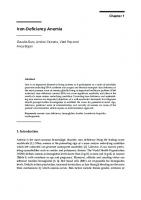Iron deficiency anemia 9781789854442, 178985444X
Iron deficiency (ID) and iron deficiency anemia (IDA) are prevalent conditions all over the world. The groups at highest
313 73 5MB
English Pages 124 [114] Year 2019
Cover
Chapter 1 Iron-Deficiency Anemia
Chapter 2 Iron Deficiency and Iron Deficiency Anemia in Children
Chapter 3 Effect of Iron Deficiency on the Increased Blood Divalent Metal Concentrations
Chapter 4 Vegetal Sources of Iron
Chapter 5 Heart Failure and Iron Deficiency
Chapter 6 Neurocognitive Dysfunctions in Iron Deficiency Patients
Recommend Papers

- Author / Uploaded
- Luis Rodrigo
File loading please wait...
Citation preview
DOI: 10.5772/intechopen.80940 Provisional chapter Chapter 1
Iron-Deficiency Iron-Deficiency Anemia Anemia Claudia Burz, Andrei Cismaru, Vlad Pop Vlad Pop and Claudia Burz, Andrei Cismaru, Anca Bojan Anca Bojan
Abstract Iron is an important element in living systems as it participates in a series of metabolic processes including DNA synthesis and oxygen and electron transport. Iron deficiency is the most common cause of anemia globally being an important healthcare problem. If left untreated, iron-deficiency anemia (IDA) can cause significant morbidity and often is the result of a more serious underlying condition. Correcting iron deficiency and replenishing iron reserves are important objectives of a well-conducted treatment, but diagnosis should prompt further investigation to establish the cause for potential reversal. Age, tolerance, preferred route of administration, and severity of anemia are some of the patient’s characteristics which require an individualized approach. Keywords: anemia, iron deficiency, hemoglobin, ferritin, transferrin, hepcidin, erythropoiesis
1. Introduction Anemia is the most common hematologic disorder, iron deficiency being the leading cause worldwide [1]. Often, anemia is the presenting sign of a more serious underlying condition which left untreated can generate consequent morbidity [2]. Likewise, it can worsen preexisting comorbidities such as cardiac and pulmonary disease. The World Health Organization (WHO) defines anemia as hemoglobin levels lower than 13 g/dL in men and 12 g/dL in women (Table 1) with variations in age and pregnancy. Moreover, altitude and smoking status can influence baseline hemoglobin [3, 4]. Red blood cells (RBC) are responsible for hemoglobin levels. Deficits in their production, increased destruction, or loss through bleeding are the main three mechanisms by which anemia occurs. Risk factors include female gender, extremes of
2
Iron Deficiency Anemia
Population
Mild anemia
Moderate anemia
Severe anemia
Children 0.5–4 years
10–10.9
7–9.9
![Iron Deficiency Anemia : Recommended Guidelines for the Prevention, Detection, and Management among U. S. Children and Women of Childbearing Age [1 ed.]
9780309586122, 9780309049870](https://ebin.pub/img/200x200/iron-deficiency-anemia-recommended-guidelines-for-the-prevention-detection-and-management-among-u-s-children-and-women-of-childbearing-age-1nbsped-9780309586122-9780309049870.jpg)






![Sickle Cell Anemia [1 ed.]
0761448217, 9780761448211](https://ebin.pub/img/200x200/sickle-cell-anemia-1nbsped-0761448217-9780761448211.jpg)

